INSTRUCTIONS TO CANDIDATES:
- Write your Name, Index Number and class in the spaces provided above.
- This paper consists of two Sections; A and B.
- Answer ALL the questions in Sections A and B in the spaces provided.
- All workings must be clearly shown.
- Non-programmable silent electronic calculators and KNEC Mathematical tables may be used.
- candidates should check the question paper to ascertain that all pages are printed as indicated and that no questions are missing.
Constants: mass of an electron, me = 9 x 10-31kg, velocity of light In vacuum = 3.0 x 108m/s, charge of an electron = 1.6 x 10-19C and the Planck's constant = 6.6 x 10-34Js.
FOR EXAMINER'S USE ONLY:
| Section | Question | Maximum Score | Candidate's Score |
| A | 1-11 | 25 | |
| B | 12 | 9 | |
| 13 | 9 | ||
| 14 | 11 | ||
| 15 | 10 | ||
| 16 | 7 | ||
| 17 | 9 | ||
| Grand Total | 80 |

QUESTIONS
Section A (25 Marks)
- The figure below shows a ray of light incident to a mirror and striking it at an angle of incidence, 45°
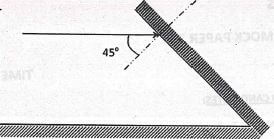
Complete the path of the path followed by the ray after reflection until the ray leaves the region between the two inclined mirrors. (2marks) -
- the figure below shows a sharp pin fixed on a cap of leaf electroscope. The electroscope is highly charged and then left for sometime.
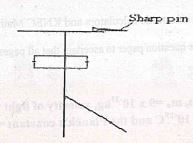
Explain why the leaf collapses. (2 marks)
- the figure below shows a sharp pin fixed on a cap of leaf electroscope. The electroscope is highly charged and then left for sometime.
- Three capacitors are connected as shown in the figure below with a battery of e.m.f 6V and zero internal resistance.
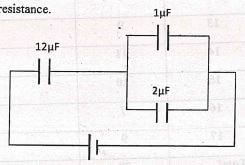
Determine the voltage across 2uF capacitor. (3marks) - Explain how local action is reduced in a simple cell. (1 mark)
- Two parallel current carrying conductors are placed close to each other as shown in the figure below.

On the same diagram sketch the magnetic field pattern and indicate the direction of the forces experienced by each conductor. (2marks) - An electric heater rated 240V, 3000W is to be connected to a 240V mains supply, through a 10A fuse. Determine whether or not the fuse is suitable. (2 marks)
- A student standing between two cliffs and 500 metres from the nearest cliff clapped his hands and heard the first echo after 3 seconds and the second echo 2 seconds later. Determine the distance between the two cliffs. (3marks)
- A ray of light makes a glancing angle of 60° with a flat glass surface as shown in the diagram below.
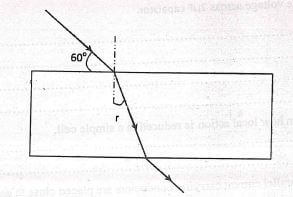
Given that the critical angle is 42°, determine the angle of refraction r. (3marks) - In Chelangat's house there are 5 bulbs each rated 240V, 40W and an electric iron rated - 240V, 900W. The bulbs are on four hours every day. She also uses electric iron for 10minutes, once a day. If the power costing is ksh.5 per kWh, determine daily charge. (3marks) Alpha particle
Radium undergoes radioactivity by emitting an alpha particle to form a daughter nuclide C as shown in nuclear equation below
Determine the values of x and y. (2 marks).
Explain what happens to the depletion layer when a diode is forward biased.
Section B (55 MARKS)
10.
- A lens forms a clear image on a screen when the distance between the screen and the object is 100. If the image is 4 times the height of the object, determine;
- The distance of the image from the lens. (2marks)
- The focal length of the lens. (2marks)
- the diagram below shows an upright object O in front of a concave lens.
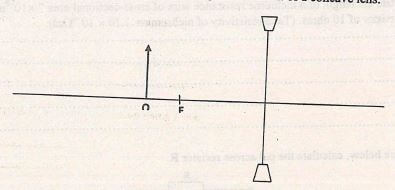
By use of correct rays, locate the position of the image. (2marks) - The figure below shows a human eye with a certain defect. A near object O is placed infront of the eye. (1)

- Name the defect. (1mark)
- Illustrate on the same diagram how the defect is corrected. (2 marks)
11.
- A cell drives a current of 5A through a 1.6Ω resistor. When connected to a 2.8Ω resistor, the current that flows in 3.2A. Find E and for the cell. (4 marks)
- Calculate the length of a nichrome resistance wire of cross-sectional area 7x10-8m2 required to make a resistor of 10 ohms. (Take resistivity of nichrome-1.10 x 10-6Ωm). (3marks)
- In figure below, calculate the p.d across resistor R. (2marks)

12.
- The figure below shows a simple cathode ray tube.
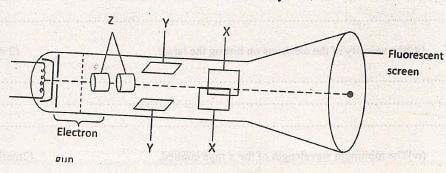
- Explain how the electrons are produced in the tube. (2 marks)
- State one function of the anode. (1 mark)
- An X-ray is operated by 30 000V and current through the tube is 20mA.( mass of an electron, mc = 9 x 10-31kg, charge of an electron = 1.6 x 10-19C and the Planck's constant 6.6 x 10-34Js.
Determine- the electrical power input. (2marks)
- the number of electrons hitting the target per second. (2 marks)
- the velocity of the electrons on hitting the target. (2 marks)
- The minimum wavelength of the x rays emitted. (2marks)
13.
- State the Faradays law of electromagnetic induction (1 mark)
- The figure below shows an experiment to illustrate electromagnetic induction using a coil and a magnet
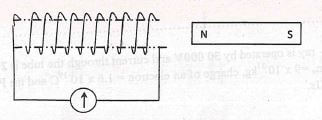
- State the observation in the galvanometer when;
- the magnet is stationary. (1mark)
- The magnet is plunged into the coil at a constant velocity. (1 mark)
- Explain how the current is produced. (2 marks)
- Show on the diagram the direction of the current in the coil when the magnet is moved toward the coil. (1mark)
- State the observation in the galvanometer when;
- a transformer is designed to supply a current of 12A at a p.d. of 80V. The inlet cable is to connected to an a.c. mains of 240V. The efficiency of this transformer is 80%. Determine:
- current in the primary coil of the transformer. (2marks)
- The power supplied to the transformer. (2marks)
14.
- The figure below shows a set up of a mass attached to a spring such that when it oscillates vertically it taps on water surface in a wide shallow tank.
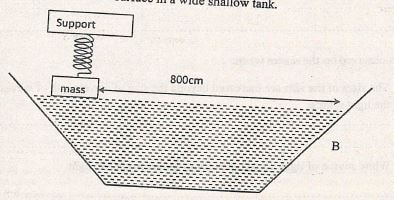
The students measured time for 10 oscillations and found that the mass takes exactly 18 seconds.- Determine the frequency of the waves produced. (2marks)
- lf a single wave front takes 2.5 s to move from point A to point B, determine the wavelength of the waves produced. (2marks)
- The figure below shows experiment to show the interference of waves
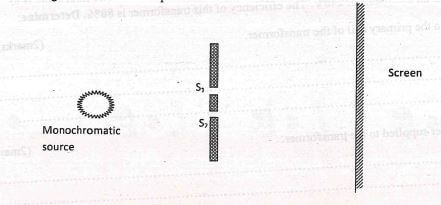
- State what is observed on the screen. (1 marks)
- What is observed on the screen when:
- The sizes of the slits are increased beyond the size of wavelength of waves produced by the light source. (1 mark)
- White White source of light is used in place of monochromatic light. (1 mark)
15.
-
- State one application of a photo emissive cell. (1mark)
- Explain how the energy of radiation affects the photo electric effect. (1marks)
- In an experiment to study the relationship between stopping potential of different lights and their corresponding frequencies, different lights were shone on a certain material and the graph of stopping potential against frequency was plotted as shown below.
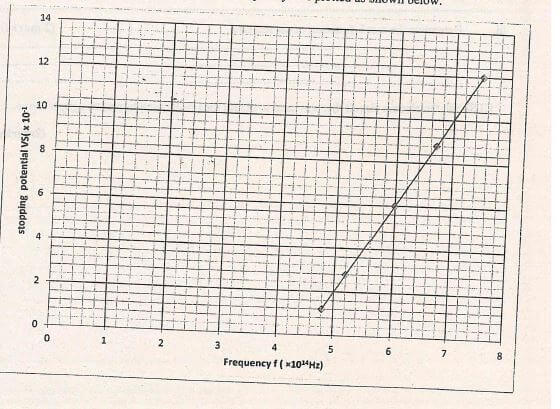
Form the graph- Determine Planck's constant, h. (2 marks)
- Determine the threshold frequency, fo (1 mark)
- Determine the work function of the material. (2 marks)
- Sketch the electric circuit that was used to obtain the results used to plot the graph above. (2 marks)

MARKING SCHEME
- Complete the path of the path followed by the ray after reflection until the ray leaves the region between the two inclined mirrors.

- Explain why the leaf collapses
- Since change as concentrated at the point the sharp point of the pin ionizes air with the same charge by point action
- Determine the voltage across 2μF capacitor
- 1 + 29 = 3μF
Qr = 12 x (1 + 2) = 36
12 + 3 15
= 2.4μF
Qt = CV = 2.4 x 6 = 14.4μc
V2μF = Or
CμF
= 14.4UC
ЗμF
= 4.8V
- 1 + 29 = 3μF
- Explain how local action is reduced in a simple cell.
- Use pure zinc
- Amalgamate zinc (when impure)
- Two parallel current carrying conductors are placed close to each other as shown in the figure below. On same diagram sketch the magnetic field pattern and indicate the direction of the forces experienced by each conductor.

- Determine whether or not the fuse is suitable
P = VI,I= O = 3000 = 12.5A
V 240
Fuse is not suitable because it must be slightly greater than 12.5A - Determine the distance between the two cliffs
- 1000
3
= 333.33m/s
d2 = vt2
2
= 333.33 x 5
2
= 833.33m
Total distance - 333.33 + 833.33 = 1166.66m
- 1000
- Given that the critical angle is 42o, determine the angle of refraction r.
n = 1
Sin 42°
= 1.494
n = Sin 30 = 1.494
SinV
Sin V = Sin 30
1.494
Sin V = 0.0047
r = sin-1(0.3347) - 19.55° - If power costing is Ksh 5 per kWh, determine dailycharge
Bulbs = 5x40w x 4h
1000
= 0.8kWh
Iron = 900w x 10/60 = 30 x 1 kWh
1000 60
= 0.15kWh
Total units = 0.8 +0.15 = 0.95kWh
Daily cost=0.95 x 5
= Kshs 4.75 - Determine values of x and y
226 = 4+x x = 226 - 4 = 222
88 = 2 +y y = 88-2-86 - Explain what happens to the depletion layer when a diode is forward biased
- Positive terminal of the battery urges the hole to move to n-type and negative terminal urges the electrons to move to p-type. This reduces the layer and it is finally eliminated and the diode starts to super conduct.
-
- Determine
- The distance of the image from the lens
n + u = 100
v
n = 4
v = 44
u +44 = 100
5u = 100 U
U = 20cm
v = 44 = 4x20 = 80cm - The focal length of the lens
1=1+1= 1 + 1
f u v 20 80
1 = 4+1 = 5
f 80 80
f = 80
5
= 16 cm
- The distance of the image from the lens
- By use of correct rays, locate the position of the image
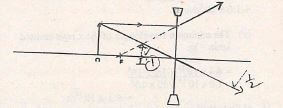
-
- name the defect
- Long sightedness (hypermetropia)
- Illustrate on the same diagram how the defect is corrected

- name the defect
- Determine
-
- Find E and r for the cell
E=IR + Ir
E= 5 (1.6) + 5r
E = 8.0 +5r
Also
E = 3.2(2.8) + 3.2r
E= 8.96 +3.2r
0 = (8.96-8) + (3.2-5)
0=0.96 + - 1.8r
1.8r = 0.96
r = 0.96
1.8
= 0.53332 - Calculate length of a nichrome resistance wire of cross-sectional area 7 x 10-8m2 required to make a resistor of 10 ohms
P= AR ,L = AR
L e
= 7.0 x 10-9 x 10
1.1 x 10-6
= 63.3636 x 10-2
= 0.6336m - Calculate the p.d across resistor R
p.d = FR = 2 x 10 = 20V
p.d across R = p.d across 10Ω =20V
- Find E and r for the cell
14.
-
- Explain how the electrons re produced in the tube
- When the circuit is on the filament heats the cathode. Electrons on the cathode gain enough K.E boil off from the cathode (or are emitted by thermonic emission. Anode Z accelerates them
towards the screen.
- When the circuit is on the filament heats the cathode. Electrons on the cathode gain enough K.E boil off from the cathode (or are emitted by thermonic emission. Anode Z accelerates them
- State one function of Z
- Accelerates electrons
- Focuses the beam of electrons
- Explain how the electrons re produced in the tube
-
- determine the electrical power input
Power = VI
= 30000 x 20 x 10-3
= 60W - The number of electrons hitting the target per second
n = I
= 20 x 10-3 = 1.25 x 107/5
1.6 x 10-19 - The velocity of the electrons on hitting the target 1/2 mvr2 = ev

- The minimum wavelength of the x rays emitted

- determine the electrical power input
15.
- State the Faradays law of electromagnetic induction
- The magnitude of induced e.m.f is directly proportional to the rate of change of magnetic lux linkage
-
- State the observation in the galvanometer when
- the magnetis stationary
- No deflection
- The magnet is plunged into the coil at a constant velocity
- Galvanometer deflects to the right and come back to zero when the magnet stops
- the magnetis stationary
- Explain how the current is produced
- As the magnet moves into the coil its field cuts the coil or the coil experiences a changing magnetic field. This creates and induced e.m.f which caused a current to flow.
- On the diagram show direction of the current
- State the observation in the galvanometer when
-
- Current in the primary coil of the transformer
IsVs = 80 lpVp
100
Ip = 100 x IsVs
80 Vp
IP = 100 x 12 x 80
80 240 - The power supplied to the transformer
P= Ip Vp = 5A x 240 = 1200/s
- Current in the primary coil of the transformer
16.
-
- Determine the frequency of the waves produced
T= 18 = 1.8s, f= 1 = 0.5556s
10 18 - Determine wavelength of the waves produced
V = 8.0m
2.5
= 3.2m/s
λ = v = 3.2m
f 0.5556
= 5.760M
- Determine the frequency of the waves produced
-
- State what is observed on the screen
- Alternating dark and bright fringes with the brightest at C
-
- The sizes of slits are increased beyond the size of wavelength of waves produced by the light source
- No diffraction & no interfering pattem
- White source of light is used in place of monochromatic light
- Spectrum of all colours of light
- The sizes of slits are increased beyond the size of wavelength of waves produced by the light source
- State what is observed on the screen
17.
-
- State one application of a photo emissive cell
- Counting vehicles
- Open door
- Burglar alarms
- Explain how energy of radiation affects the photo electric effect
- Energy of radiation (hf) will increase the KE of electrons emitted.
- State one application of a photo emissive cell
- from graph determine
- Determine Planck's constant, h.
- Determine the threshold frequency
fo = 4.5 x 1014HZ
Range (4.4 to 4.6) x 1014HZ - Determine the work function of the material
Wo = ho = 6.4 x 10-34 x 4.5 x 1014
= 2.88 x 10-19J
- Determine Planck's constant, h.
- Sketch electric circuit that was used to obtain results used to plot the graph above
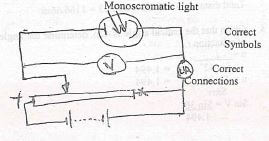
Download Physics Paper 2 Questions and Answers - Sukellemo Joint Mock Examinations July 2020.
Tap Here to Download for 50/-
Get on WhatsApp for 50/-
Why download?
- ✔ To read offline at any time.
- ✔ To Print at your convenience
- ✔ Share Easily with Friends / Students


